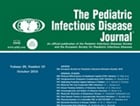Abstract and Introduction
Abstract
Background: Otitis media is a common and costly disease that peaks in early childhood. Recent reviews concluded that the relationship between otitis media and atopy is not well understood, and that further research is warranted.
Methods: Logistic regression was used to analyze data from a German Birth Cohort (n = 1690; born 1997–1999). Parental questionnaires were used to assess children for physician-diagnosed otitis media throughout the first 2 years of life and for incident atopic disease (asthma, allergic rhinitis, and eczema) during the sixth year of life. Odds ratios were adjusted for gender, older siblings, city, parental education, breast-feeding, and daycare. Parallel analyses were completed for the full birth cohort and for a population subset with atopic mothers.
Results: The adjusted odds of asthma were elevated for children with early-life otitis media, but were statistically significant only for those children with at least 3 episodes (adjusted odds ratio: 4.26 [95% confidence interval: 1.34–13.6]). Associations between early-life otitis media and allergic rhinitis were largely inconsistent. There was a positive association between early-life otitis media and late-onset allergic eczema (≥2 episodes: 2.68 [1.35–5.33], ≥3 episodes: 3.84 [1.80–8.18]). Similar results were found for the maternal atopy subgroup but with greater effect estimates.
Conclusions: Children diagnosed with otitis media during infancy were at greater risk for developing late-onset allergic eczema and asthma during school age, and associations were stronger for frequent otitis. These results indicate that frequent otitis media during infancy may predispose children to atopic disease in later life.
Introduction
Otitis media, or middle ear infection, is one of the most common reasons children visit a physician or are prescribed antibiotics during the first years of life.[1] The resultant burden of otitis media is substantial,[2] but the true long-term consequences of frequent otitis media during infancy are not well understood.
There are numerous pathogens responsible for acute otitis media, which include Streptococcus pneumoniae, Haemophilus influenzae, respiratory syncytial virus (RSV), rhinovirus, influenza, and adenovirus.[3–5] Some of these are also responsible for other common childhood infections, such as rhinovirus (the common cold), RSV (bronchiolitis), and influenza (flu). Despite considerable study, there remains following 2 conflicting hypotheses regarding the relationship between these infections in early life and development of atopic disease: (i) that repeated infections in early life can induce atopic disease, and (ii) that repeated infections in early life can inhibit atopic disease—the hygiene hypothesis.[6] Although there is overwhelming evidence in support of the hygiene hypothesis, there also exists evidence for the first hypothesis—even across studies that have examined the same infectious agent.[7] There is also the critical issue of temporality, because allergic inflammation of the respiratory epithelium may predispose a child to respiratory infection, specifically the environment required for acute otitis media. And conversely, the respiratory epithelium can become inflamed during viral infection (rhinovirus, RSV, influenza), and these same viruses can induce wheeze and asthmatic symptoms.[8] Therefore, the study of otitis media and respiratory allergic disease is not a straightforward issue.
Recent reviews concluded that the relationship between otitis media and atopy is not well understood, and that further research is warranted.[9,10] We used prospectively collected data on physician-diagnosed otitis media and atopic disease in a population-based birth cohort to examine the association between otitis media during the first 2 years of life and incident atopic disease during the sixth year. This study provides further insight into the complex relationship between early infection and atopic disease, adding to previous knowledge by comparing disease frequency and by considering the association with eczema, a nonrespiratory atopic disease.
Pediatr Infect Dis J. 2010;29(12):e96-e99. © 2010 Lippincott Williams & Wilkins
Cite this: Early-life Otitis Media and Incident Atopic Disease at School Age in a Birth Cohort - Medscape - Dec 01, 2010.












Comments